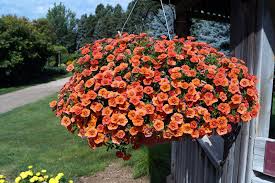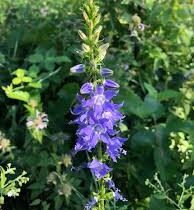Calibrachoa , commonly known as million bells, is a charming and vibrant flowering plant celebrated for its abundant blooms and trailing growth habit. Perfect for containers, hanging baskets, and garden beds, calibrachoa adds a splash of color to any outdoor space. Here’s everything you need to know about growing and caring for calibrachoa.
Definition and Benefits of Calibrachoa
Calibrachoa belongs to the family Solanaceae and is a close relative of petunias. This plant is known for its small, petunia-like flowers and vigorous growth. Key benefits include:
- Continuous Blooms: Calibrachoa produces an abundance of flowers from spring until frost, providing lasting color.
- Versatility: Ideal for containers, hanging baskets, and mixed flower beds, making it a great choice for various garden designs.
- Drought Resistance: Once established, calibrachoa is relatively drought-tolerant, requiring less frequent watering.
- Low Maintenance: With minimal care, calibrachoa can thrive, making it perfect for busy gardeners.
Basics of Calibrachoa
- Common Name: Calibrachoa / Million Bells
- Botanical Name: Calibrachoa spp.
- Family: Solanaceae
- Plant Type: Perennial (often grown as an annual)
- Mature Size: 6–12 inches tall, spreading 12–24 inches wide
- Sun Exposure: Full sun
- Soil Type: Well-draining potting mix or garden soil
- Soil pH: Slightly acidic to neutral (6.0 to 7.0)
- Bloom Time: Spring to fall
- Flower Color: Available in a variety of colors, including purple, pink, yellow, red, and bicolor
- Hardiness Zones: 9-11 (USDA); often treated as an annual in cooler regions
- Native Area: Native to South America
Choosing Which Calibrachoa to Grow
Several popular varieties of calibrachoa are available, each with unique characteristics:
1. Calibrachoa ‘Cabaret’
- Description: Known for its vibrant, large flowers with a variety of color patterns, including bicolors.
- Ideal Uses: Perfect for hanging baskets and mixed containers.
2. Calibrachoa ‘Million Bells’
- Description: A classic choice with numerous small blooms that create a stunning floral display.
- Ideal Uses: Excellent for borders and as ground cover.
3. Calibrachoa ‘Superbells’
- Description: Features larger flowers and a more compact growth habit, ideal for garden beds and containers.
- Ideal Uses: Great for both containers and garden settings.
When to Plant Calibrachoa
Getting the Planting Site Ready
Calibrachoa thrives in full sun, so choose a location that receives at least 6 hours of direct sunlight daily. Use well-draining soil to prevent waterlogging.
Timing for Planting
- Indoors: Start seeds indoors 8-10 weeks before the last frost date for early blooms.
- Outdoors: Plant after the last frost in spring to ensure healthy growth.
Specific Timing for Different Regions
- Tropical Areas: Can be planted year-round.
- Temperate Regions: Best planted in late spring to early summer.
Growing Calibrachoa
Planting Location
Calibrachoa prefers full sun and should be planted in a location with good air circulation. This helps prevent diseases and promotes healthy growth.
Spacing
Space calibrachoa plants about 10 to 12 inches apart to allow for adequate air circulation and growth.
Care and Maintenance
Watering
Water calibrachoa regularly, especially during hot, dry periods. Allow the top inch of soil to dry out between waterings to prevent root rot. Be cautious not to let the plant sit in water.
Fertilization
Feed calibrachoa every 4-6 weeks during the growing season with a balanced, water-soluble fertilizer to promote healthy growth and abundant blooms.
Pruning and Maintenance
Regularly deadhead spent flowers to encourage continuous blooming. Prune back any leggy growth to maintain a bushy appearance and enhance flowering.
Pest and Disease Management
Calibrachoa is relatively pest-resistant, but keep an eye out for aphids, spider mites, and whiteflies. Treat infestations with insecticidal soap or neem oil as needed.
Pests and Diseases
Identifying and Treating Diseases
Common diseases affecting calibrachoa include powdery mildew and root rot. Ensure good air circulation and avoid waterlogging to prevent these issues. Treat fungal infections with appropriate fungicides if necessary.
Identifying and Fixing Signs of Distress
Watch for yellowing leaves or stunted growth, which may indicate overwatering or nutrient deficiencies. Adjust care practices accordingly to remedy these issues.
Planting Calibrachoa in the Garden
How to Use Calibrachoa
Calibrachoa is versatile and can be used in various ways:
- Containers: Excellent for window boxes, hanging baskets, and patio pots.
- Borders: Ideal for edging and mixed flower beds, adding color and texture.
- Ground Cover: Can spread to cover bare soil, creating a lush, colorful carpet.
Companion Planting
Pair calibrachoa with other sun-loving annuals and perennials, such as petunias, marigolds, or lantana, for a stunning floral display.
End of Season Care for Calibrachoa
As the growing season comes to an end, consider these care tips:
- Indoor Plants: If you live in a cooler climate, bring container calibrachoa indoors before the first frost. Reduce watering during the dormant winter months.
- Outdoor Plants: In warmer climates, calibrachoa can survive winter outdoors; however, in cooler regions, consider treating them as annuals.
Propagation
Calibrachoa can be propagated from stem cuttings taken in the spring. Allow cuttings to callus for a few hours before planting them in a well-draining mix.
Additional Tips for Successful Growth
- Humidity: Calibrachoa prefers moderate humidity and should be protected from overly humid conditions to prevent fungal diseases.
- Temperature: Ideal temperatures range from 65-75°F (18-24°C). Protect them from extreme cold or heat.
- Soil Quality: Use a high-quality potting mix that drains well to encourage healthy root growth.








Leave a Reply
View Comments